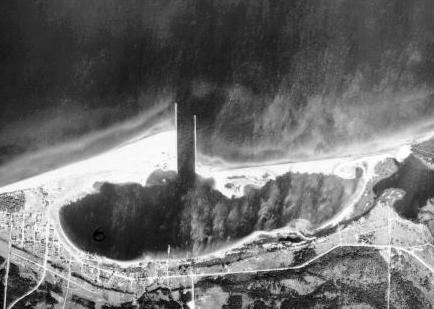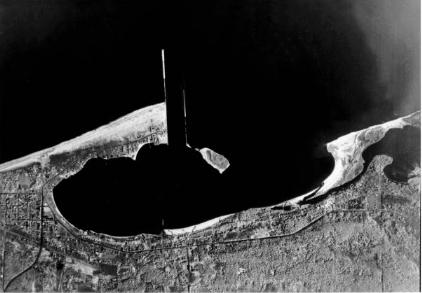 Grand
Marais Harbor, 1939
Grand
Marais Harbor, 1939
History of the Breakwater
Grand Marais has been the site of a beautiful natural harbor for hundreds of years. Early explorers noted that it provided a refuge from Lake Superior's storms, and by the mid-1800's it was a well-known sheltering spot along the southern shore of Lake Superior. In 1880 Grand Marais was designated an official Harbor of Refuge, the only one along a 90-mile stretch from Whitefish Point to Munising. In order to protect the harbor, the Corps of Engineers built two jetties out into the lake from the harbor, and constructed a 5770-foot timber-pile breakwater from the east jetty to Lonesome Point. This effectively closed in the harbor and prevented its being shoaled in by sand.
By the 1940s, commercial fishing and lumbering in the area had declined and the Corps of Engineers no longer maintained the breakwater. Without maintenance, it wasn't long before it was totally destroyed. Once the breakwater disappeared, sand began filling in the bay at an alarming rate. The original 55-foot depth of the bay has decreased; today the maximum depth is only 25 feet, and Lonesome Point has severely eroded. Much of that sand ends up in Grand Marais harbor. Sand is currently being deposited in the harbor at the rate of 100,000 cubic yards per year. If the harbor is to survive, something must be done to stop the shoaling.
Below are two aerial photos of Grand Marais harbor.
Note the changes in the shoreline after the breakwall disappeared.
 Grand
Marais Harbor, 1939
Grand
Marais Harbor, 1939
 Grand
Marais Harbor, 1964
Grand
Marais Harbor, 1964
Current Status of the Harbor Restoration Project
The Harbor Committee was formed in order to investigate the re-construction of the breakwall. Their efforts have paid off. In 1998, Congress authorized funds to have an independent study of the harbor and the breakwall situation. Dr. Guy Meadows, director of the Ocean Engineering Lab and the University of Michigan College of Naval Architecure and Marine Engineering, conducted the study last summer using a special underwater rover. Dr. Meadows is a respected authority on breakwall construction whose ideas have been sought out by the Navy and the Corps of Engineers in the past. Dr. Meadows' preliminary report, detailing three options for correcting the damage to the harbor, was prepared in time for Congressional Budget appropriations requests in February, 2000.